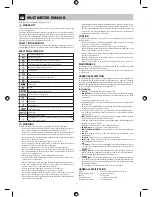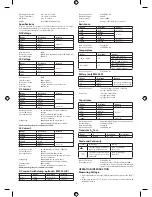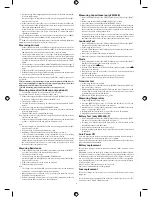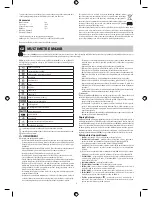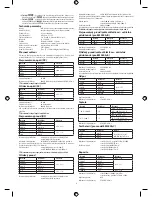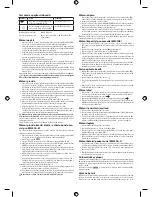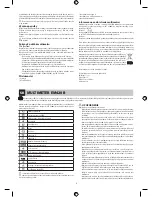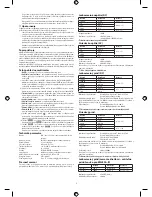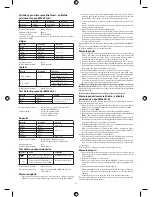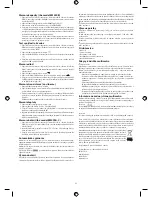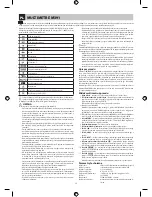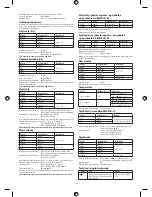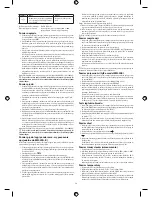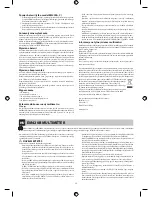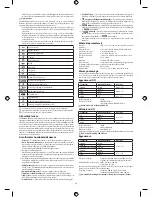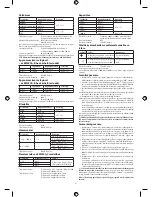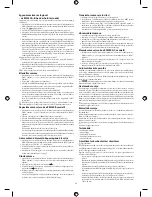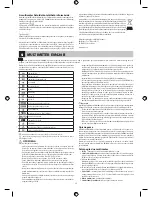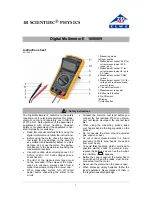
4
3. In manual range, if the voltage magnitude to be measures is not know beforehand,
select the highest range.
In manual range mode, when the meter shows the overrange symbol “OL“ a higher
range has to be selected
4. Connect the test leads across the source or load to be measured – Read the read-
ing on the display. For DC voltage measurement, the polarity of the red test lead
connection will be indicated as well.
In small range, the meter may display an unstable reading when the test leads
have not been connected to the load to be measured. It is normal and will not
affect the measurements.
Note: To avoid damage to the meter, don´t measure a voltage which exceeds 600Vdc
(for DC voltage measurement) or 600 Vac( for AC voltage measurement).
If 600 V is reached, the measuring must be terminated immediately. Otherwise
multimeter can be damaged or electrical shock may occur.
Measuring Current
1. Connect the black test lead to the “COM“ jack. If the current to be measured is less
than 200 mA, connect to red test lead to the “INPUT“ jack. If the current is between
200 mA and 10 A, connect the red test lead to the “10 A“ jack instead.
2. Set the range switch to µA , mA or A range. If the current magnitude to be
measured is not know beforehand, set the range switch to the highest range
position and then reduce it range by range until satisfactory resolution is obtained.
3. Select DC current measurement or AC current measurement with the “FUNC.“
Button
4. Select autorange or manual range with the “RANGE“ button. In manual range, if
the current magnitude to be measured is not know beforehand, select the highest
range.
5. Connect test leads in series with the circuit to be measured.
6. Read the reading on the display. For DC current measurement, the polarity of the
red test lead connection will be indicated as well.
Note: When the display shows the overrange symbol “OL“ a higher range has to
be selected.
Never measure current if voltage in open circuit is higher than 250V. Measur-
ing of current with higher voltage in open circuit may damage the product (fuse
burning, electrical discharge) or electrical shock.
When measuring, please make sure that correct range is used!
Mesuring Current (with clamp, only optional)
1. If you want measure DC current, you must use the DC clamp.
If you want measure AC current, you must use the AC clamp.
2. Connect the negative(-) output lead of the select clamp to the “COM“ jack, connect
to positive (+)output lead of the clamp to the “INPUT“ jack.
3. Set the range switch to position.
4. Select DC current measurement or AC current measurement with the “FUNC.“
button
5. Select auto range or manual range with “RANGE“ button.
In manual range, if the current magnitude to be measured is not know beforehand,
select the highest range.
6. Clamp the cable to be measured with the clamp
Note: Each time only one cable should be clamped and the cable should be in the
center of the clamp jaws.
7. Read the reading on the display. For DC current measurement, the polarity of the
positive (+) output lead of the clamp will be indicated as well.
Note:
1. In manual range mode, when the meter shows the overrange symbol “OL“ a higher
range has to be selected
2. Don´t touch the circuit under test with hand or skin.
3. Matching problem about the meter and the sensitivity of the clamp:
a) The sensitivity of the matching clamp is 0,1A/0,1mV. If you use a matching
clamp, the present indicated value is same to the measured value.
b) If you use a clamp whose sensitivity does n´t equal is 0,1A/0,1mV, you should
multiply the present reading by a factor which is determined by the used clamp,
the result is the measured value. To determine the factor, please refer to the
instruction of the clamp which you use.
Mesuring Resistance
1. Connect the black test lead to the “COM“ jack and the red test lead to the “INPUT“
jack. (Note: The polarity of the red test lead is po“).
2. Set the range switch to Ω range
3. Select auto range or manual range with the “RANGE“ button.
In manual range mode, when the meter shows the overrange symbol “OL“ a higher
range has to be selected.
4. Connect the test leads across the load to be measured.
5. Read the reading on the display.
Note:
1. For resistance measurement >1MΩ, the meter may také a few second to stabilize
reading. This is normal for high-resistance measurement.
2. When the input is not connected, i.e. at open circuit, zhe symbol “OL“ will be
displayed as an overrange indicator.
3. Before measuring in-circuit resistance, be sure that the circuit under test has all
power removed and all capacitors are fully discharged.
Measuring Capacitance (only EM420B)
1. Connect the black test lead to the “COM“ jack and the red test lead to the “INPUT“
jack.
2. Set the range switch to desired“1000µF“,“20µF“ or “nF“ position.
3. Select auto range or manual range with the “RANGE“ button.
4. Connect the test leads across the capacitor to be measured. Make sure thet the
polarity of connection is observed. (The redtest lead should be connected to the
anode of the capacitor, the black one should be connected to the cathode of the
capacitor) – Read the reading on the display.
In small range, before the test leads are connected to the capacitor, the display
may show a reading, it is normal because of the stray capacitance of the test leads
and input circuit of the meter. It will not affect the measurement accuracy.
Continuity Test
1. Connect the black test lead to the “COM“ jack and the red test lead to the “INPUT“
jack. (Note: The polarity of the red test lead is po“).
2. Set the range switch to range.
3. Press the “FUNC.“ Button to select continuity measurement mode and the symbol
will appear as an indicator.
4. Connect the test leads to the circuit to be measured.
5. If the circuit resistance is lower than about 30Ω, the built-in buzzer will sound.
Diode
1. Connect the black test lead to the “COM“ jack and the red test lead to the “INPUT“
jack. (Note: The polarity of the red test lead is po“).
2. Set the range switch to
range.
3. Press the “FUNC.“ Button to select diode measurement mode and the symbol
will appear as an indicator.
4. Connect the red test lead to the anode of the diode to be tested and the black
test lead to the cathode.
5. The meter will show the approximate forward voltage of the diode.
If the connections are reversed, “OL“ will be shown on the display.
Transistor test
1. Set the range switch to h
FE
position
2. Refer to the figure 2, connect the adapter to the “COM“ jack an the “INPUT“ jack.
Don´t reverse the connection.
3. Identify whether the transistor is NPN or PNP type and locate emitter, base and
collector lead. Insert the leads of the transistor to be tested into to proper holes
of the transistor test socket of the adapter.
4. LCD display will show the approximate h
FE
value
Measuring Temperature
1. Set the range switch to Temp range
2. Press the “FUNC.“ button to select °C or °F mode, and the symbol °C or °F mode
and symbol “°C“ nebo “°F“ will appear as an indicator.
3. Insert the black (or “-“) plug of the K type thermocouple to the “COM“ jack and the
red (or “+“) plug to the “INPUT“ jack.
4. Carefully touch the end the thermocouple to the object to be measured.
5. Wait a while, read the reading on the display.
Battery Test (only EM420A, C)
1. Connect the black test lead to the “COM“ jack and the red test lead to the “INPUT“
jack. (Note: The polarity of the red test lead is po“).
2. According to the different type off the battery (1,5V, 3V, 9V) to be tested, set the
range switch to the desired BATT range.
3. Connect the test leads to the battery to be tested.
4. Read the reading on the display. The polarity of the red test lead connection will
be indicated.
Auto Power Off
If you don´t operate the meter for about 15 minutes, it will turn of automatically. To
turn on it again, just rotate the range switch or press a button.
If you press the button to arouse the meter after it turns off automatically, the automatic
power-off function will be disabled.
Battery replacement
Before battery change, test leads must be disconnected off the measured circuit/
equipment.
When symbol appears on the display, it shows that the battery should be replaced.
To replace the battery, use an appropriate screwdriver to gently rotate the rotary lock
on the battery cover by 90° in the indicated direction (refer to figure 3). Remove bat-
tery cover, replace the exhausted batteries with new bateries of the same type(AAA
type). Reinstall the batery cover and gently rotate the rotary lock by 90° clockswise
to lock the battery cover.
Note: Excess force will cause damage to the rotary lock.
Don´t use a screwdriver which is not big enough.
Fuse replacement
Before fuse change, test leads must be disconnected off the measured circuit/
equipment.
Fuse rarely needs replacement and is blown almost as a result of operator’s errors. This
meter uses a fuse: F 250mA L 250V, fast action.


